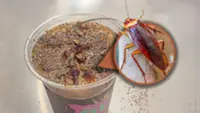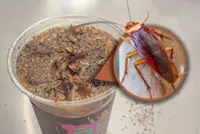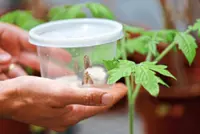Food for animals is fueling demand for insect protein, which could jump 4,900% from 2021 to half a million metric tons by the end of the decade. — Dreamstime/TNS
FOR their first attempt at making food from insects, Sean Warner and Patrick Pittaluga started with a bug burger.
Their patty, which combined black beans with black soldier fly larvae, was cooked up at their Georgia Tech apartment not long after the United Nations had published an influential 2013 report that touted insects as the future of food, a natural resource that could help with rising meat costs and climate concerns as the global population grows.
But the bug burger didn’t taste great, and before long, the entrepreneurs steered their Grubbly Farms brand to focus on insect-based food for dogs and chickens.
The pivot from feeding humans to furry and feathered creatures was a practical adaptation to what many startups and established brands have seen in their attempts to build a market for these ingredients: Whatever the environmental good, people just aren’t yet willing to eat bugs. But they are perfectly happy to feed the critters to their pets.
Food for animals is fuelling demand for insect protein, which could jump 4,900% from 2021 to half a million metric tons by the end of the decade, according to a Rabobank report.
Those prospects for growth have drawn venture capitalists to the fledgling industry. Investors plowed US$76.77mil (RM365mil) into insect-based food companies in 2022 and another US$14.92mil (RM70.9mil) last year, according to PitchBook data. Mark Cuban and Robert Downey Jr are among the investors who have put money into insect protein companies.
The startups face a tricky balancing act as they try to create demand for their products – one that has led them away from catering to human diners.
“Being too early is just as risky as being too late,” says Phil Poirier, co-founder of Montreal-based Wilder Harrier, whose products include cricket dog snacks and black soldier fly dry food.
Health-minded appeals
Diners have proven a tough crowd for insect-protein evangelists. Only a quarter of consumers in the United States are willing to incorporate insect ingredients into their regular diet, according to a 2021 YouGov survey that had a similar finding for key European markets like Germany and the United Kingdom.
The reticence reflects that some people are unsettled by the idea of eating bugs – but also the challenge that insect proteins aren’t yet filling a specific taste or nutritional void.
“Outside of sustainability, in the human food application, edible insects aren’t exactly solving a clear pain point,” says Alessandro Di Trapani, the co-founder of insect dog food maker Grub Club Pets.
That has left the animal market as much more fertile territory. Pet food made with crickets and black soldier fly larvae is sold by major retailers including Petco and Chewy.
Tyson Foods announced a partnership in October with insect supplier Protix to build a facility in the US to make insect proteins and fats to be used in pet food and animal agriculture. Mars Inc sells dry cat food made with black soldier fly larvae in the UK.
Insect-based foods have caught on in pet aisles with product descriptions that appeal to health-minded shoppers, including saying that the food doesn’t trigger dog’s allergies and is good for sensitive stomachs.
Anne Carlson, the founder of Jiminy’s cricket-based pet food, saw a stronger business model – and potential for greater environmental impact – in feeding canines.
“Dogs eat the same thing every day, and if you swap it with a sustainable alternative, you basically get all of their eating occasions,” says Carlson, who makes dog food, treats and dental chews.
“That’s not the case for people. Best-case scenario, maybe I get your breakfast every day with a bar.”
So far, pet food has driven the volume growth in the insect protein market, said Gorjan Nikolik, a senior analyst at Rabobank who co-authored the report on the segment’s potential.
But he expects rapid change: Once more research is conducted and larger-scale production lowers prices, Nikolik sees aquaculture becoming the biggest buyer of insect proteins, using them as feed for fish and other seafood. Pet food, however, is still expected to account for about 30% of demand in 2030, he said.
Most livestock and farmed fish are still fed traditional soy or fishmeal, which is cheaper than insect feed. As researchers assess whether insects can have “functional benefits” like supporting faster growth or a lower mortality rate, Nikolik said demand from commercial farmers or those feed products could increase.
‘Multi-decade process’
Many insect-based pet foods in the US are black soldier fly products for dogs. That’s because the ingredient was the first insect protein to be formally approved for use in adult dogs by the Association of American Feed Control Officials in 2022. The association doesn’t regulate products, but the designation means the ingredient has been deemed safe and effective by the association and the FDA Center for Veterinary Medicine, according to AAFCO executive director Austin Therrell.
Dried crickets received formal approval for use in adult dog food in January, and mealworms received tentative approval the same month. No insects are approved in cat diets, though discussions have taken place surrounding black soldier fly larvae, Therrell said.
Meanwhile, the industry hasn’t given up on one day feeding masses of people.
Even though Grubbly Farms never proceeded with its insect burger patty, co-founder Warner maintains that “a chef could have spiced them up a bit” and made them tasty enough to market. He is still hopeful insects will become a mainstay of human diets, though he thinks that will be a “multi-decade process.”
Jarrod Goldin, who co-founded Ontario-based Entomo Farms in 2014, said he had hoped the adoption by humans of insect products “would have been more meaningful” after a decade. The company still believes it will happen, but for now, about 70% of the crickets it grows go toward pet food.
At this point, people find it easier to purchase insect-based food when they see it as a way to “combat” a culture of feeding corn and soy to animals that don’t naturally eat those ingredients, said Aly Moore, the chief communications officer at Oregon-based Chapul Farms.
The company primarily sells black soldier fly products to be used as animal feed and fertiliser. Its human-grade cricket powder only accounts for 5% to 10% of sales.
“It just makes too much sense to feed insects to animals that don’t care if they’re eating bugs in the same way that humans do,” Moore said. — Bloomberg





